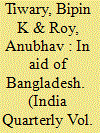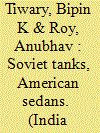|
|
|
Sort Order |
|
|
|
Items / Page
|
|
|
|
|
|
|
| Srl | Item |
| 1 |
ID:
143071


|
|
|
| 2 |
ID:
187129


|
|
|
|
|
| Summary/Abstract |
India’s all-out war with Pakistan for the liberation of Bangladesh in 1971 may have been brief, but it came after a lengthy prelude. For months, New Delhi laboured to convince the world—especially the West—about the grim consequences of Islamabad’s oppressive bid to stomp out Bengali nationalism in East Pakistan. While there is adequate literature chronicling the diplomatic persuasion undertaken by India leading up to the war of 1971 and its military pursuits during the conflict, the academic interest in the civil society’s contribution to the cause appears insufficient. A dearth of retrospective case studies of India’s socio-cultural responses to its foreign affairs is, in fact, noticeable, especially in the discourse on Indian soft power. In an attempt to address this gap, by principally relying on the historical evaluative analysis of primary news reports, this article attempts to chronicle the contributions towards the cause of East Pakistan’s liberation by individual and collective civil society actors of Bombay (now Mumbai)—a cultural and commercial hub of India—focusing on the efforts of a dedicated volunteer-run committee for fundraising, the fraternity of the city’s Bollywood celebrities, and a few distinguishable films produced within it. In doing so, the potential of these actors to qualify as resources of India’s soft power during that tense year is also examined.
|
|
|
|
|
|
|
|
|
|
|
|
|
|
|
|
| 3 |
ID:
181907


|
|
|
|
|
| Summary/Abstract |
While a worrying disrepair in the political-military strand of the equation between New Delhi and Beijing prevailed through the 2010s, its economic component witnessed contrasting instances of convergence. By examining India’s business linkages with China during the period, especially through its railway and automobile industries, this article attempts to empirically demonstrate how Indian public and private sector actors managed to consistently cultivate a network of complex interdependence with their Chinese counterparts, resultantly keeping Beijing engaged in multiple, mutually beneficial non-military agendas and contributing to the mitigation of recurring bilateral strife.
|
|
|
|
|
|
|
|
|
|
|
|
|
|
|
|
| 4 |
ID:
176991


|
|
|
|
|
| Summary/Abstract |
Having fought its third war and staring at food shortages, independent India needed to get its act together both militarily and economically by the mid-1960s. With the United States revoking its military assistance and delaying its food aid despite New Delhi’s devaluation of the rupee, India’s newly elected Indira Gandhi government turned to deepen its ties with the Soviet Union in 1966 with the aim of balancing the United States internally through a rearmament campaign and externally through a formal alliance with Moscow. The US formation of a triumvirate with Pakistan and China in India’s neighbourhood only bolstered its intent. Yet India consciously limited the extent of both its balancing strategies and allowed adequate space to simultaneously adopt the contradictory sustenance of its complex interdependence with the United States economically. Did this contrasting choice of strategies constitute India’s recourse to hedging after 1966 until 1971, when it liberated Bangladesh by militarily defeating a US-aligned Pakistan? Utilising a historical-evaluative study of archival data and the contents of a few Bollywood films from the period, this paper seeks to address the question by empirically establishing the extents of India’s balancing of, and complex interdependence with, the United States.
|
|
|
|
|
|
|
|
|
|
|
|
|
|
|
|
|
|
|
|
|